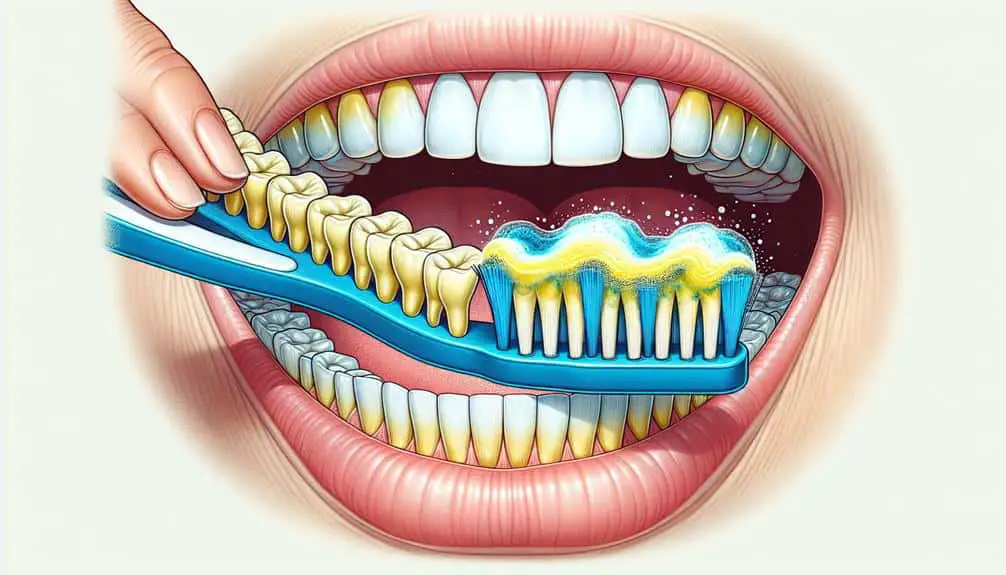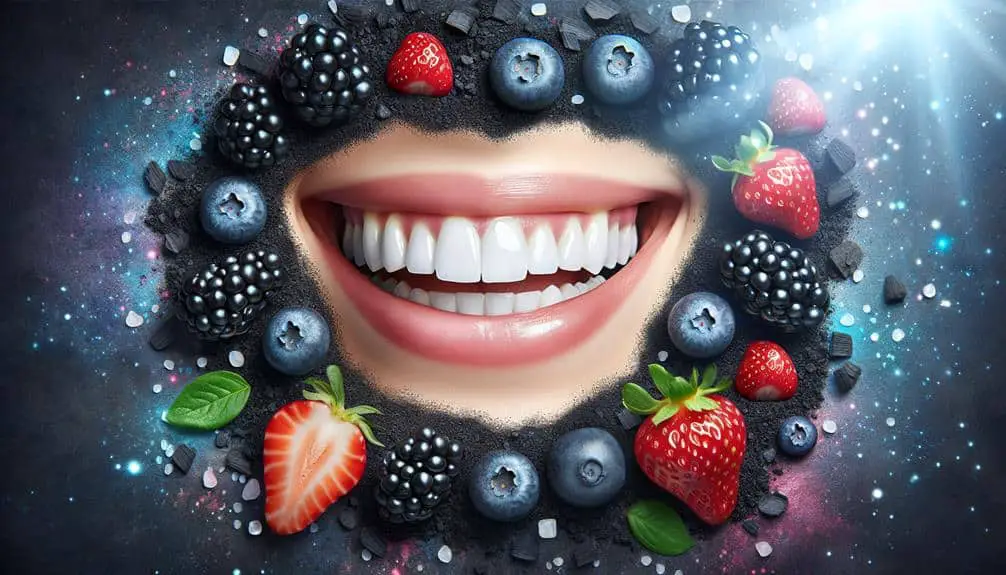For the best fluoride stain whitening, consider professional treatments like laser therapy or in-office bleaching. At-home kits with gel trays and whitening strips offer convenience. Opt for whitening toothpaste containing hydrogen peroxide for daily use. Natural remedies such as oil pulling can also help. Prevent future staining by maintaining oral hygiene and avoiding teeth-staining foods. These methods can give you a brighter smile.
Key Points
- Professional whitening treatments like laser and in-office bleaching are effective for removing fluoride stains.
- At-home whitening kits with gel trays and whitening strips offer convenience and cost-effective solutions.
- Whitening toothpaste containing hydrogen peroxide or carbamide peroxide helps break down stains when used consistently.
- Natural remedies like oil pulling with coconut or sesame oil can reduce stains and improve oral health.
- Prevent future staining by maintaining good oral hygiene, limiting stain-causing foods, and avoiding tobacco products.
Professional Whitening Treatments
Wondering which professional whitening treatments are the most effective for removing fluoride stains from your teeth?
When it comes to combating fluoride stains, two prominent methods stand out: laser treatment and in-office bleaching.
Laser treatment involves the use of a focused light beam to activate whitening agents on your teeth, effectively breaking down the stains and leaving your teeth brighter. This method is known for its precision and quick results, making it a popular choice for many seeking to eliminate stubborn fluoride stains.
On the other hand, in-office bleaching is a tried and tested method where a bleaching agent is applied to your teeth, and a special light is used to enhance the whitening process. This technique is performed under professional supervision, ensuring safety and optimal results. In-office bleaching is known for its effectiveness in removing tough stains, including those caused by fluoride, giving you a brighter and more radiant smile.
When considering professional whitening treatments for fluoride stains, both laser treatment and in-office bleaching offer reliable solutions worth exploring.
At-Home Whitening Kits
For individuals seeking a convenient and cost-effective way to address fluoride stains on their teeth, at-home whitening kits provide a practical solution. At-home whitening kits typically include gel trays and whitening strips that can effectively help reduce fluoride stains and brighten your smile in the comfort of your own home. Gel trays are customized to fit your teeth, guaranteeing even distribution of the whitening agent and maximizing its effectiveness. Whitening strips are easy to apply and can target specific areas affected by fluoride stains.
Using at-home whitening kits requires consistency and following the instructions carefully to achieve best results. It's crucial to understand the duration and frequency of use recommended by the manufacturer to avoid damaging your teeth or gums. While these kits can be a great option for many individuals, it's always advisable to consult with your dentist before starting any whitening treatment to make sure it's suitable for your specific needs.
Whitening Toothpaste Options
Consider incorporating whitening toothpaste into your daily oral care routine as a simple yet effective way to combat fluoride stains and maintain a brighter smile. When selecting a whitening toothpaste, look for key ingredients such as hydrogen peroxide or carbamide peroxide, which are effective in breaking down stains on the teeth's surface. These ingredients work by oxidizing the stains, resulting in a brighter appearance over time. Additionally, some whitening toothpaste products contain gentle abrasives like silica, which can help polish the teeth and remove surface stains effectively.
To maximize the effectiveness of whitening toothpaste in preventing fluoride stains, using the product consistently as part of your daily oral hygiene routine is crucial. Brush your teeth at least twice a day, especially after consuming foods or beverages known to cause staining. Moreover, consider incorporating other fluoride stain prevention techniques like using a straw when drinking dark-colored beverages and rinsing your mouth with water after consuming staining foods. By combining these strategies, you can effectively combat fluoride stains and maintain a radiant smile.
Natural Remedies for Stains
Looking to naturally combat stains on your teeth? Natural remedies can be an effective way to brighten your smile. One popular method is oil pulling, where you swish a tablespoon of coconut or sesame oil in your mouth for about 15-20 minutes. This practice is believed to remove toxins and bacteria, helping to reduce stains and promote overall oral health. Oil pulling benefits include potential teeth whitening effects and improved gum health.
However, it's essential to be cautious when using lemon juice as a natural teeth whitening remedy. Lemon juice is acidic and can erode the enamel on your teeth, leading to increased sensitivity and vulnerability to staining. The acid in lemon juice can also wear down the outer layer of your teeth, making them more prone to discoloration. It's advisable to use lemon juice sparingly and always rinse your mouth thoroughly with water after application to minimize potential risks to your dental health.
Preventing Future Staining
To prevent future staining on your teeth, maintaining a consistent oral hygiene routine is essential. This routine should include brushing your teeth at least twice a day with fluoride toothpaste, flossing daily, and visiting your dentist regularly for check-ups and cleanings.
In addition to oral hygiene practices, making some diet changes can help prevent staining. Limiting the consumption of foods and drinks that are known to stain teeth, such as coffee, tea, red wine, and sugary beverages, can greatly reduce the risk of developing new stains.
Furthermore, being mindful of your daily habits can also play a role in preventing future staining. For instance, avoiding smoking or using tobacco products can help keep your teeth free from unsightly stains. Additionally, drinking plenty of water throughout the day can help wash away food particles and prevent staining.
Frequently Asked Questions
Can Fluoride Stains Be Completely Removed With Whitening Treatments, or Are They Only Able to Be Lightened?
When considering fluoride stain removal, it's important to understand that whitening treatments can lighten stains effectively. While complete removal may not always be achievable, consistent maintenance with proper methods can lead to long-term whitening results.
Are There Any Specific Foods or Drinks That Should Be Avoided to Prevent Further Staining After Whitening Treatments?
To maintain your newly whitened smile and prevent stains, be mindful of your diet. Avoid foods like berries and beverages like coffee that can cause staining. Opt for stain-resistant alternatives to prolong your whitening results.
How Long Do the Effects of Professional Whitening Treatments Typically Last Before Needing to Be Redone?
You'll be amazed by the lasting brilliance of professional whitening treatments. With proper maintenance, their effects can endure for up to a year. Schedule periodic touch-ups to prevent stains and keep your smile glowing.
Are There Any Potential Side Effects or Risks Associated With Using At-Home Whitening Kits for Fluoride Stains?
When using at-home whitening kits for fluoride stains, be aware of potential risks like tooth sensitivity or gum irritation. Consider effectiveness comparison with professional treatments. Consult your dentist for personalized advice on safe whitening methods.
Are There Any Specific Dental Conditions That May Make Individuals Ineligible for Certain Whitening Methods for Fluoride Stains?
Before deciding on a whitening treatment for fluoride stains, consider dental contraindications. Not all methods may be suitable due to existing conditions. Your dentist can assess whitening eligibility based on your individual situation and recommend appropriate options.



